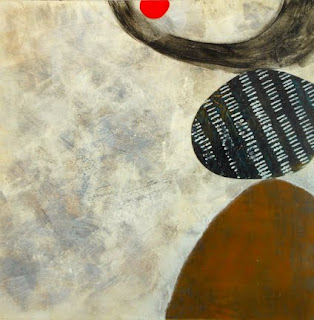In November, I
reported about my experience with the first session of Methods & Materials in Acrylic, a class taught by
Melanie Matthews at the Montreal Museum of Fine Arts. Melanie is a "Golden Certified Working Artist", so she has lots of expertise with acrylic paints and knows how to make them behave.
 |
| Hilda af Klint, Svanen (The Swan) No. 17 , 1914-15 |
Melanie structured the second session so that each of the six three-hour classes was inspired by the work of a particular artist. By learning about
Hilma af Klint (Swedish, 1862 - 1944), we were introduced to the colour wheel, variations of which featured prominently in her work. We began with three primaries and mixed multiple secondary colours. It's remarkable to see how this little-known artist grappled with a hard-edge, "target" style of abstraction more than 100 years ago.
 |
| Pat Steir, Waterfall, 1988 |
The second class was devoted to
Pat Steir (American, born 1940), whose use of dripped paint suggests falling water. We used this opportunity to prepare our canvases with three different tinted substrates (light molding paste, coarse molding paste, and acrylic ground for pastel or AGP). Each went on a little differently and produced slightly different effects as a base for the dripping. We tilted the prepared canvas on a supporting board, dribbled on high flow acrylic, and encouraged the paint to flow downwards with a spritz of water.
 |
| Viktor Vasarely, Hexa 5, 1988 |
Stencils were provided for the third class, which allowed us to produce a Victor Vasarely (Hungarian, French, 1906-1997) type of geometric design. We played with the concept of colours advancing and receding, and with the suggestion of form using dark, medium and light values. We made transparent paints more opaque with the addition of Titanium White. Vasarely is known for his hard-edge paintings, but our time was limited and so we didn't have a chance to use painter's tape and gel medium to create a true hard edge.
 |
| Georgio Morandi, Still Life, 1951 |
Georgio Morandi (Italian, 1890-1964) is known for his still lifes, which use a very limited neutral palette. In the fourth class we learned how to mix complementary colours (for example, Prussian Blue and Burnt Sienna) and tint with lots of white to create a range of interesting neutrals.
 |
| Morris Louis, Para I, 1959 |
For the fifth class, the focus was on
Morris Louis (American, 1912 - 1962), who celebrated transparent colours by painting broad swaths of them on raw canvas. We diluted our paints with Acrylic Flow Release OR clear Palmolive dish soap solution OR diluted alcohol, and observed how each affected the dispersal of the paint. The idea here is to reduce the surface tension of the High Flow acrylic paint so that it penetrates the raw canvas, staining it rather than simply lying on the surface.
 |
| David Salle, Mr. Lucky, 1998 |
For the sixth and final class (which I was unable to attend), we looked at how the artist David Salle (American, born 1952) chops up seemingly disparate images from a variety of sources and assembles them in a new way. It was suggested that students select parts of their various assignments and juxtapose them with each other. Stretching canvas on stretcher bars and mounting on panels was also demonstrated.
Though I wasn't particularly satisfied with the canvases I produced, I saw the classes as opportunities to explore the nature of the materials. I've included my exercises below. Melanie is a knowledgeable and energetic teacher with a good strategy for presenting the techniques.
 |
| transparent and opaque paints, primary and secondary colours |
 |
| dripping dilute paint onto three different tinted surfaces |
 |
| tints and shades to create a shifting sense of volume |
 |
| mixing subtle neutrals from complementary colours |
 |
| staining the canvas by adding dispersing agents to paint |
And with Golden supplying all the paints, pastes, gels and mediums, we felt free to explore all the possibilities presented.

































